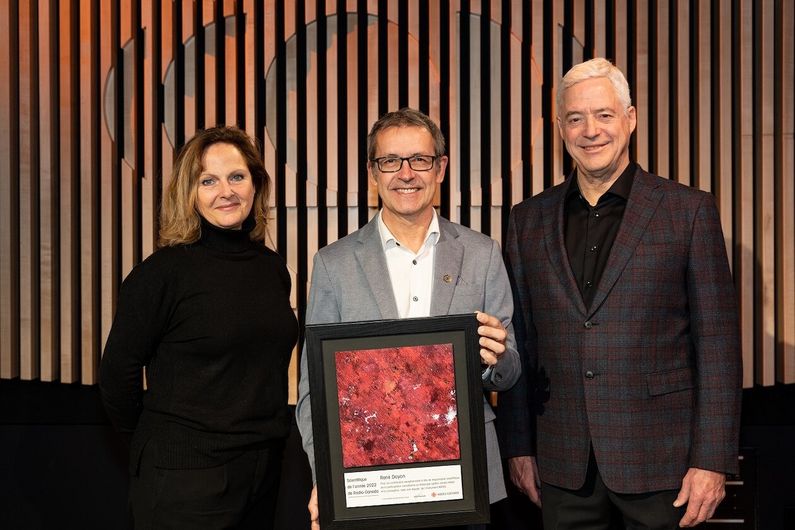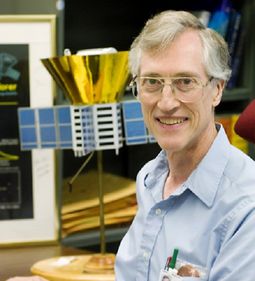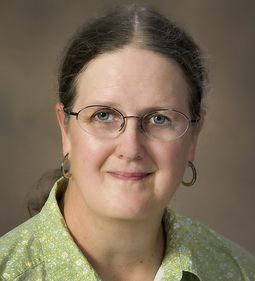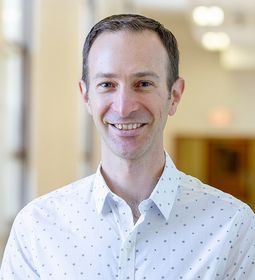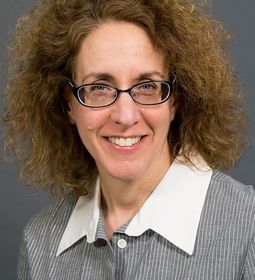René Doyon: A scientific star with both feet firmly planted on the ground
- UdeMNouvelles
01/29/2023
- Béatrice St-Cyr-Leroux
Astrophysicist René Doyon has just been named Radio-Canada’s Scientist of the Year 2022. We spoke with some of his current and former colleagues about what makes his work simply “out of this world.”
He's one of the four minds behind the instruments that make up the James Webb Space Telescope (JWST), the most complex piece of equipment ever built by humans. He was on the team that captured the first images of a planetary system outside our solar system.
In addition to serving as director of the Trottier Institute for Research on Exoplanets and the Mont-Mégantic Observatory, he uses his unique expertise to develop astronomical instruments to search for life “where no man has gone before.”
René Doyon, a professor at the Université de Montréal's Department of Physics, is an extraordinary astrophysicist. This is the second time that Radio-Canada, the CBC’s French-language service, has named him Scientist of the Year.
Although his work focuses on finding out whether we're alone in the universe, it's obvious that he's got plenty of people behind him. We talked to four colleagues who believe this most recent honour is very well-deserved.
John C. Mather
John C. Mather is a Nobel laureate in physics and senior astrophysicist at NASA’s Goddard Space Flight Center, as well as the senior project scientist at the JWST. He leads the telescope's science team and represents scientific interests within the project management team.
Doyon started working with Mather when he took the lead role in developing the Canadian-built components of the JWST after his predecessor (John Hutchings) retired.
“I love working with René. He took over leading the Canadian contribution to JWST when the previous lead (John Hutchings) retired, and he made sure that the hardware works perfectly. As it turned out there was also a major problem that he had to solve: the Canadian instrument (now called NIRISS) was designed around a part that could not be manufactured, after all. René very quickly made a new design that could be built, and he and his team delivered it in time for integration into the JWST ISIM (Integrated Science Instrument Module). René is also a fine scientist with many projects underway in the search for exoplanets. Congratulations to René for this recognition!”
Marcia Reike
Marcia Reike is a professor of astronomy at the University of Arizona and the principal investigator for the JWST’s near-infrared camera (NIRCam). The NIRCam is one of the instruments that allow the JWST to capture images of regions of space where visible light is blocked by interstellar dust.
Reike is the person who asked Doyon to join the project. The NIRCam was initially meant to be built jointly by the United States and Canada. The Canadian component was later split off from the NIRCam to become its own separate Canadian instrument, the NIRISS.
“René guided the transition and then subsequently moved the instrument through a number of technical challenges and delivered a beautiful instrument with new capabilities that I had not dreamed of. He more than rewarded my invitation with this instrument but also by being a great JWST Science Working Group member over the many years since I invited him to participate back in 2001.”
David Lafrenière
David Lafrenière is an astrophysicist and professor at Université de Montréal’s physics department who has worked with Doyon for many years. Along with their colleague Christian Marois, the trio made a name for themselves internationally in 2008, when they published the first direct image of a system of exoplanets, captured using an imaging technique they developed themselves.
That year, Radio-Canada named all three of them as its “Scientist of the Year.”
“René Doyon is a tremendous asset! He's got great intuition for finding and carrying out the right project, the people skills and the energy to bring the necessary resources together, the ability to meet challenges and the determination to finish the job regardless of the problems that arise. He'll say that his successes are all down to teamwork. And that’s true. But he's the one who's built, led and inspired that team. I’ve been a close colleague of his for a long time, so I've seen how the projects he selects, his actions and his relentless work ethic are always guided by his drive to support his team members, offer them the best opportunities and let them shine.
Victoria Kaspi
Victoria Kaspi is a physics professor at McGill University, as well as an astrophysicist and director of McGill’s Trottier Space Institute. She's known for her research on collapsed stars and is the first woman to win the Gerhard Herzberg Canada Gold Medal, a prestigious science prize awarded by the Natural Sciences and Engineering Research Council.
“I am delighted to hear the news that my friend and colleague René Doyon will be honoured in this way. I have for a long time admired his excellent work and achievements and felt he was an "unsung hero" here in Quebec. I have had many opportunities to interact with him particularly on issues related to our institutes, and I have found him to be an extremely reasonable and fair colleague, one who I can count on for wisdom and sincerity.”


